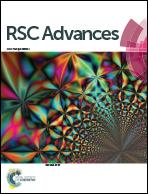Nanosilica-supported thiosemicarbazide–glutaraldehyde polymer for selective Au(iii) removal from aqueous solution
Abstract
A new adsorbent thiosemicarbazide/nanosilica composite was synthesized via a facile two-step reaction, including the functionalization of silica nanoparticles via amino groups, and crosslinking the thiosemicarbazide with glutaraldehyde onto the amino functionalized silica nanoparticles. The adsorption capability of the adsorbent for Au(III) ions was investigated. Fourier transform infrared, X-ray photoelectron spectroscopy and thermogravimetric analysis were used to characterize the adsorbent. Experimental results indicated that nanocomposites exhibited highly selective and efficient adsorption for Au(III). The equilibrium data fitted well with the Langmuir isotherm and the obtained kinetic data obeyed the pseudo-second-order kinetics model. The maximum adsorption capacity was 4.3 mmol g−1 at pH 2. The adsorbent can still keep high adsorption capability after five recycling rounds. The adsorption mechanisms were proposed as the synergistic effect of ionic interaction and chelation.



 Please wait while we load your content...
Please wait while we load your content...